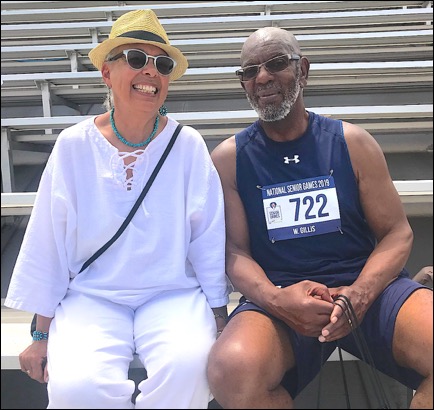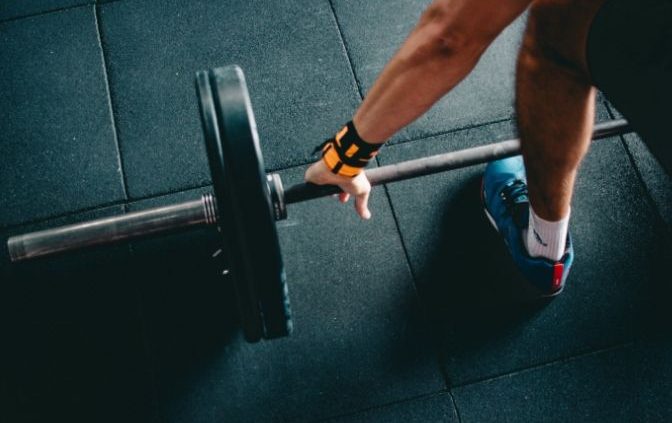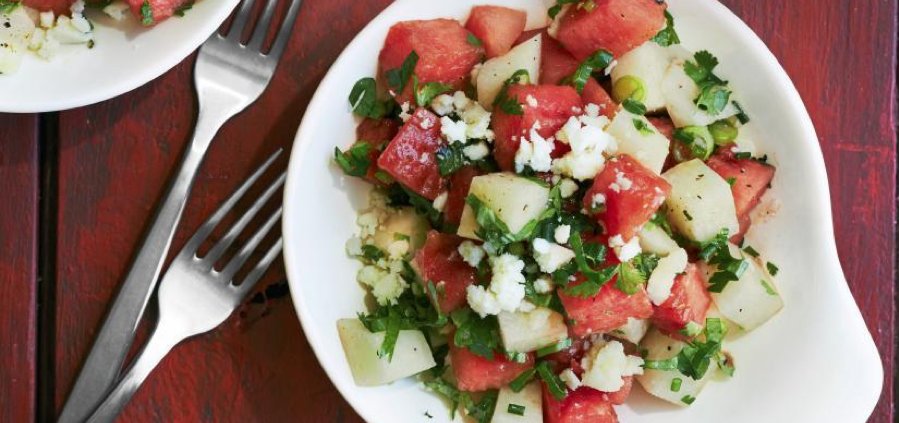Exercise Proves a Powerful Weapon against Cancer: Meet a Man Who Knows It First Hand
|Posted by Natania GoldbergBill Gillis has always been an athlete, running and lifting weights for most of his 71 years. His healthy lifestyle choices helped more than he could’ve imagined when he was diagnosed with Stage 4 abdominal cancer in 2015 and given an 11 percent chance to live.
“I never missed a workout and had no side effects through six rounds of chemo and 15 days of radiation,” said Bill, above with his wife, Isabelle, during a break from racing at the National Senior Games in Albuquerque.
“My doctor says I’m wasting his time whenever I show up in his office,” said the business consultant, who lives in the San Francisco Bay Area and is thriving in his fourth year of remission.
Inspiring Others to Exercise
Bill Gillis knows he’s setting a good example for others young and old to exercise.
Isabelle, 77, is proud, too, when people at their community gym ask her husband for fitness advice.
“He’s a role model for so many younger people,” she says. “Every morning, they’re constantly coming up to him, asking questions – How did you do it? And saying thanks for being the inspiration.”
Sources: Harvard Medical School, The American Cancer Society, The National Cancer Institute, WebMD
Exercise vs. Cancer: The Research
|Posted by Natania GoldbergResearch proves that exercise is good for our health at any age. Experts say it also helps prevent cancer and lower its risk of recurring. Regular exercise benefits cancer survivors the same way it helps the general population – by reducing obesity and blood pressure, lowering risk of heart attack, stroke and diabetes.
Strength training is particularly important to help maintain muscle and bone density. People generally lose muscle mass with age, and cancer exacerbates the decline. Chemotherapy can cause women to lose 10 times as much bone density as normal, according to Josie Gardiner, a personal trainer who co-authored “The Breast Cancer Survivor’s Fitness Plan.”
Some patients also gain fat from treatment. We know that strength and aerobic exercise are great for fighting weight gain.
The American Cancer Society recommends most adults get “at least 30 to 60 minutes of moderate to vigorous physical activity at least five days a week.” Following this protocol can reduce the risk of cancer in the first place and is helpful for cancer patients as well.
The National Cancer Institute shares powerful data about how exercise can reduce the risk of certain cancers:
- Breast cancer by 20 to 80 percent
- Endometrial cancer by 20 to 40 percent
- Colon cancer by 30 to 40 percentAustralia Issues National Guidelines.
The Clinical Oncology Society of Australia last year became the first national cancer organization to issue formal guidelines that recommend exercise as a part of treatment for all cancer patients.The organization said:
- Exercise should be a part of standard care for cancer patients to fight the disease and side effects of treatment.
- Treatment teams should promote physical activity so patients meet exercise guidelines.
- Patients should be referred to an exercise physiologist or physical therapist.
“If we could turn the benefits of exercise into a pill it would be demanded by patients, prescribed by every cancer specialist and subsidized by government,” said Dr. Prue Cormie, author of the organization’s report. “It would be seen as a major breakthrough in cancer treatment.
Sources: Harvard Medical School, The American Cancer Society, The National Cancer Institute, WebMD
Watermelon-Jicama Salad
|Posted by Natania GoldbergFor a light but tasty summer side, the basil pairs perfectly with watermelon, and jalapeño gives it a spicy kick.
Ingredients
- 8 cups cubed watermelon (1/2-inch pieces)
- 1 cup cubed peeled jicama (1/2-inch pieces)
- 1 tablespoon lime zest
- 1 jalapeno pepper, stemmed, seeded, deveined and minced
- 1 tablespoon sliced scallion, white and pale green parts only
- 1/4 cup roughly chopped fresh cilantro
- 1/4 cup thinly sliced fresh basil
- 2 tablespoons fresh lime juice
- 1 tablespoon fresh lemon juice
- 3 tablespoons extra-virgin olive oil
- Kosher salt and freshly ground pepper
- 1/2 cup crumbled Cotija cheese
Directions
- Combine the watermelon and jicama in a large bowl. Add the lime zest. Stir in the jalapeno, chives, scallion, cilantro and basil. Mix well.
- In a separate small bowl, whisk the lime juice, lemon juice and olive oil until blended. Season to taste with salt and pepper and drizzle over the watermelon-jicama mixture. Toss in the Cotija cheese. Check the seasoning and add more salt and pepper if needed.
- Serve immediately or cover and refrigerate up to 2 hours.
Makes 4-6 servings
From The Food Network
Exercise Proves a Powerful Weapon against Cancer: Meet a Man Who Knows It First Hand
|Posted by Natania GoldbergBill Gillis has always been an athlete, running and lifting weights for most of his 71 years. His healthy lifestyle choices helped more than he could’ve imagined when he was diagnosed with Stage 4 abdominal cancer in 2015 and given an 11 percent chance to live.
“I never missed a workout and had no side effects through six rounds of chemo and 15 days of radiation,” said Bill, above with his wife, Isabelle, during a break from racing at the National Senior Games in Albuquerque.
“My doctor says I’m wasting his time whenever I show up in his office,” said the business consultant, who lives in the San Francisco Bay Area and is thriving in his fourth year of remission.
Inspiring Others to Exercise
Bill Gillis knows he’s setting a good example for others young and old to exercise.
Isabelle, 77, is proud, too, when people at their community gym ask her husband for fitness advice.
“He’s a role model for so many younger people,” she says. “Every morning, they’re constantly coming up to him, asking questions – How did you do it? And saying thanks for being the inspiration.”
Sources: Harvard Medical School, The American Cancer Society, The National Cancer Institute, WebMD
Exercise vs. Cancer: The Research
|Posted by Natania GoldbergResearch proves that exercise is good for our health at any age. Experts say it also helps prevent cancer and lower its risk of recurring. Regular exercise benefits cancer survivors the same way it helps the general population – by reducing obesity and blood pressure, lowering risk of heart attack, stroke and diabetes.
Strength training is particularly important to help maintain muscle and bone density. People generally lose muscle mass with age, and cancer exacerbates the decline. Chemotherapy can cause women to lose 10 times as much bone density as normal, according to Josie Gardiner, a personal trainer who co-authored “The Breast Cancer Survivor’s Fitness Plan.”
Some patients also gain fat from treatment. We know that strength and aerobic exercise are great for fighting weight gain.
The American Cancer Society recommends most adults get “at least 30 to 60 minutes of moderate to vigorous physical activity at least five days a week.” Following this protocol can reduce the risk of cancer in the first place and is helpful for cancer patients as well.
The National Cancer Institute shares powerful data about how exercise can reduce the risk of certain cancers:
- Breast cancer by 20 to 80 percent
- Endometrial cancer by 20 to 40 percent
- Colon cancer by 30 to 40 percentAustralia Issues National Guidelines.
The Clinical Oncology Society of Australia last year became the first national cancer organization to issue formal guidelines that recommend exercise as a part of treatment for all cancer patients.The organization said:
- Exercise should be a part of standard care for cancer patients to fight the disease and side effects of treatment.
- Treatment teams should promote physical activity so patients meet exercise guidelines.
- Patients should be referred to an exercise physiologist or physical therapist.
“If we could turn the benefits of exercise into a pill it would be demanded by patients, prescribed by every cancer specialist and subsidized by government,” said Dr. Prue Cormie, author of the organization’s report. “It would be seen as a major breakthrough in cancer treatment.
Sources: Harvard Medical School, The American Cancer Society, The National Cancer Institute, WebMD
Watermelon-Jicama Salad
|Posted by Natania GoldbergFor a light but tasty summer side, the basil pairs perfectly with watermelon, and jalapeño gives it a spicy kick.
Ingredients
- 8 cups cubed watermelon (1/2-inch pieces)
- 1 cup cubed peeled jicama (1/2-inch pieces)
- 1 tablespoon lime zest
- 1 jalapeno pepper, stemmed, seeded, deveined and minced
- 1 tablespoon sliced scallion, white and pale green parts only
- 1/4 cup roughly chopped fresh cilantro
- 1/4 cup thinly sliced fresh basil
- 2 tablespoons fresh lime juice
- 1 tablespoon fresh lemon juice
- 3 tablespoons extra-virgin olive oil
- Kosher salt and freshly ground pepper
- 1/2 cup crumbled Cotija cheese
Directions
- Combine the watermelon and jicama in a large bowl. Add the lime zest. Stir in the jalapeno, chives, scallion, cilantro and basil. Mix well.
- In a separate small bowl, whisk the lime juice, lemon juice and olive oil until blended. Season to taste with salt and pepper and drizzle over the watermelon-jicama mixture. Toss in the Cotija cheese. Check the seasoning and add more salt and pepper if needed.
- Serve immediately or cover and refrigerate up to 2 hours.
Makes 4-6 servings
From The Food Network




Nothing Found
Sorry, no posts matched your criteria